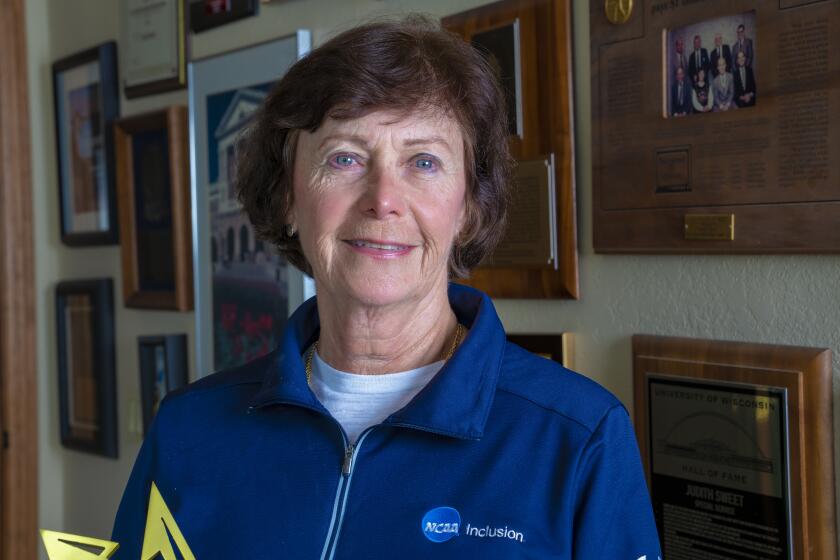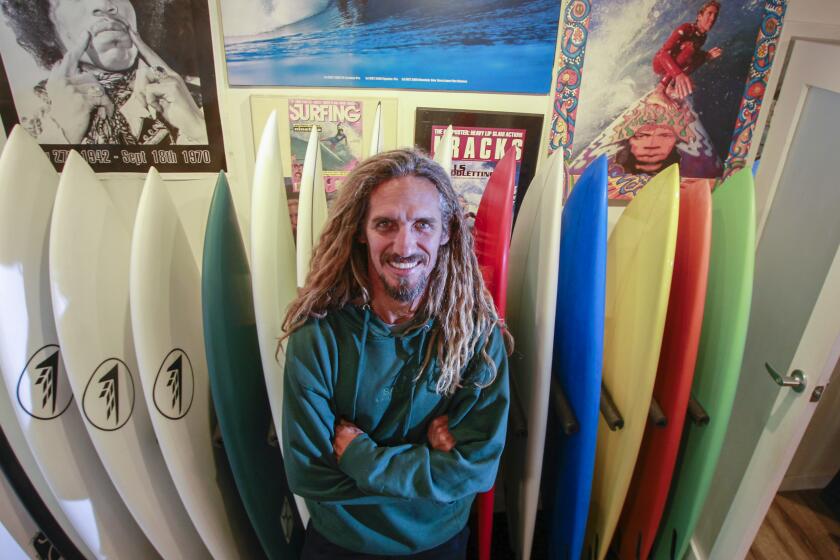As clock ticks toward Breeders’ Cup, Del Mar’s summer season opens
There is a digital clock in the foyer of the executive offices of the Del Mar Thoroughbred Club. Its bright red numbers are in constant movement.
Late Monday morning the clock read: 108 days, 12 hours, 23 minutes. And at that moment, 25 seconds.
That is the countdown to when Del Mar will host for the first time the biggest two days in horse racing, the Breeders’ Cup, on Nov. 3-4.
Glancing at the clock, one occupant of the office joked, “If you look at that clock too much, it will drive you crazy.”
Tickets going fast but still available for Breeders’ Cup »
It is a reminder of the much-welcomed worldwide attention that will come for a race track that still is a mystery to some, while also emphasizing that Del Mar, in its 78th season, will be under more scrutiny than ever, beginning with the summer meeting that starts Wednesday.
“There’s definitely a different flavor in the air,” Del Mar CEO and President Joe Harper said Monday. “It smells a little more international.”
Entering his 41st season at the track, Harper was not his usual natty and well-coiffed self. He stood in the shade of some trees by the paddock, wearing a faded black polo, dusty black work pants and hiking shoes. The former Hollywood child actor looked like he’d just returned from pitching hay on the backstretch.
Two days before the women in their outrageous hats were to arrive, hands were getting dirty all over the place in preparation. And yet Harper was still less harried than he was last year at this time. The 2016 meeting opened on Friday, July 15, with a quick 11-day turnaround after the San Diego County Fair.
This year, Del Mar cut its racing schedule by three days with the hopes of giving its new superintendent more time to prepare the track while affording horses a longer rest following the close of Santa Anita’s meet July 4.
“We lose some money, but frankly, it was the right thing to do,” Harper said. “It gave us more time to get ready. It gave the horsemen more time on the track before the races start. We’re breathing a little easier.”
The breath holding will come on opening day and in the subsequent seven weeks as Del Mar tries to overcome the bad memories and negative publicity that came with 17 horse deaths in last year’s summer meeting and another five in the shorter fall season.
Protests from animal rights advocates grew more fervent as the summer season progressed and the deaths mounted, and Harper concluded at the end of the meet, “You look for a smoking gun, and sometimes there just isn’t one. The nature of the sport came to roost on our porch this summer.
“We’re going to be doing many things that we hope will cut down on these problems in the future.”
Harper and Del Mar appear to have kept their promise in attempting to make the racing safer.
Beyond shortening the meet, Del Mar hired well-respected Santa Anita superintendent Dennis Moore to create a dirt racing surface that’s more consistent with Santa Anita’s; turns on the course were further banked to relieve stress on the horses’ legs; at least 200 fewer horses will be housed at Del Mar, reducing the number of overall workouts; and Harper said a system of greater scrutiny among veterinarians and track workers has been instituted in an effort to identify unhealthy horses before they’re entered in a race.
Any horse that hasn’t raced in more than a year will be carefully watched, Harper said.
“I was out there this morning and saw a horse that was a little sore,” Harper said. “It doesn’t mean he’s going to snap his leg off, and they may not run him, but those are the horses you want to take a closer look at.”
On Monday, Hall of Fame trainer Bob Baffert said he had yet to breeze horses on the new Del Mar track, but added that he’d heard “good things” from jockeys after workouts began Saturday.
Baffert is a staunch defender of Del Mar’s practices and noted he trained the current No. 1 horse in the world, Arrogate, here all last summer and brought the winner of $17 million to race at Del Mar twice this summer before entering him in the Breeders’ Cup Classic.
“If I was worried about it, I wouldn’t be here with my horses,” Baffert said.
He added, “One thing that’s different here is the air. It’s heavy. The horses get tired, not so much because of the track but because of the air. A lot of horses will get tired the first time you work them, and that plays into it.”
Baffert said he was encouraged by the hiring of Moore, whom he contends is among the best superintendents in the business.
Moore was not available for comment early in the week, but Harper said Moore has closely examined the track, digging down to the “sub-base” to find even small inconsistencies.
It was Moore who also suggested the extra banking, bringing Del Mar to a 5-degree grade that is the same as Santa Anita’s. The additional work was done at a cost of $250,000, Harper said.
“Race track maintenance has changed so much,” said Tom Robbins, a Del Mar executive vice president who oversees racing. “Years ago it was 90 percent art and 10 percent science. Now it’s 60 percent art and 40 percent science. Dennis is one of those guys who embraces the scientific part.”
Robbins has his own set of circumstances that have him feeling a little more nervous than usual heading into the meet. It’s his job to fill the eight to 10 races on the card for five days each week, and that became more concerning after Santa Anita had to cancel several days of racing this past meet for lack of entries.
Asked if he could envision that happening at Del Mar, Robbins said, “I would have said no until I saw it happen. It is unsettling. We’re doing our best to sort of calm everybody down, because it affects a lot of people who are employed in our industry.”
Harper said, “Our field sizes have been relatively good, even higher than Saratoga’s the last couple of years. We’re all feeling the drop in foal crops across the country. It started when everybody went broke in ’08 and all of a sudden there weren’t horses being bred for a couple of years, so you’re always kind of feeling that.”
Robbins said he is encouraged by what appears to be a larger crop of 2-year-olds that could be ready to race in the near future.
Del Mar started its “Ship & Win” program seven years ago to encourage owners to bring in horses from outside of California to race. It has been a success, Robbins said, and this summer the bonus has been raised by $500 to $1,500 when an out-of-state horse races for the first time. Those horses also get a 30-percent bonus on whatever they earn in their first start.
Harper said he thinks the fact Del Mar is on the clock for the Breeders’ Cup will bring around more owners and trainers, and possibly, horses to race.
“I think it’s becoming more than just a curiosity,” Harper said. “Nobody wants to show up at a place they’ve never been before, with a few million bucks worth of horses, and just toss them in there.”
Sports Videos
Go deeper inside the Padres
Get our free Padres Daily newsletter, free to your inbox every day of the season.
You may occasionally receive promotional content from the San Diego Union-Tribune.









